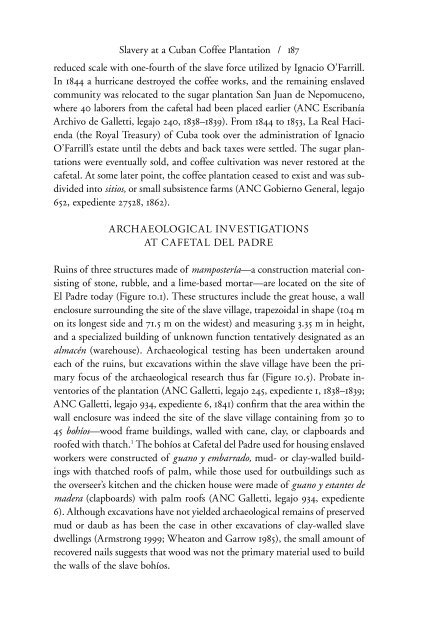Dialogues in Cuban Archaeology
by L. Antonio Curet, Shannon Lee Dawdy, and Gabino La Rosa Corzo
by L. Antonio Curet, Shannon Lee Dawdy, and Gabino La Rosa Corzo
You also want an ePaper? Increase the reach of your titles
YUMPU automatically turns print PDFs into web optimized ePapers that Google loves.
Slavery at a <strong>Cuban</strong> Coffee Plantation / 187<br />
reduced scale with one-fourth of the slave force utilized by Ignacio O’Farrill.<br />
In 1844 a hurricane destroyed the coffee works, and the rema<strong>in</strong><strong>in</strong>g enslaved<br />
community was relocated to the sugar plantation San Juan de Nepomuceno,<br />
where 40 laborers from the cafetal had been placed earlier (ANC Escribanía<br />
Archivo de Galletti, legajo 240, 1838–1839). From 1844 to 1853, La Real Hacienda<br />
(the Royal Treasury) of Cuba took over the adm<strong>in</strong>istration of Ignacio<br />
O’Farrill’s estate until the debts and back taxes were settled. The sugar plantations<br />
were eventually sold, and coffee cultivation was never restored at the<br />
cafetal. At some later po<strong>in</strong>t, the coffee plantation ceased to exist and was subdivided<br />
<strong>in</strong>to sitios, or small subsistence farms (ANC Gobierno General, legajo<br />
652, expediente 27528, 1862).<br />
ARCHAEOLOGICAL INVESTIGATIONS<br />
AT CAFETAL DEL PADRE<br />
Ru<strong>in</strong>s of three structures made of mampostería—a construction material consist<strong>in</strong>g<br />
of stone, rubble, and a lime-based mortar—are located on the site of<br />
El Padre today (Figure 10.1). These structures <strong>in</strong>clude the great house, a wall<br />
enclosure surround<strong>in</strong>g the site of the slave village, trapezoidal <strong>in</strong> shape (104 m<br />
on its longest side and 71.5 m on the widest) and measur<strong>in</strong>g 3.35 m <strong>in</strong> height,<br />
and a specialized build<strong>in</strong>g of unknown function tentatively designated as an<br />
almacén (warehouse). Archaeological test<strong>in</strong>g has been undertaken around<br />
each of the ru<strong>in</strong>s, but excavations with<strong>in</strong> the slave village have been the primary<br />
focus of the archaeological research thus far (Figure 10.5). Probate <strong>in</strong>ventories<br />
of the plantation (ANC Galletti, legajo 245, expediente 1, 1838–1839;<br />
ANC Galletti, legajo 934, expediente 6, 1841) con¤rm that the area with<strong>in</strong> the<br />
wall enclosure was <strong>in</strong>deed the site of the slave village conta<strong>in</strong><strong>in</strong>g from 30 to<br />
45 bohíos—wood frame build<strong>in</strong>gs, walled with cane, clay, or clapboards and<br />
roofed with thatch. 1 The bohíos at Cafetal del Padre used for hous<strong>in</strong>g enslaved<br />
workers were constructed of guano y embarrado, mud- or clay-walled build<strong>in</strong>gs<br />
with thatched roofs of palm, while those used for outbuild<strong>in</strong>gs such as<br />
the overseer’s kitchen and the chicken house were made of guano y estantes de<br />
madera (clapboards) with palm roofs (ANC Galletti, legajo 934, expediente<br />
6). Although excavations have not yielded archaeological rema<strong>in</strong>s of preserved<br />
mud or daub as has been the case <strong>in</strong> other excavations of clay-walled slave<br />
dwell<strong>in</strong>gs (Armstrong 1999; Wheaton and Garrow 1985), the small amount of<br />
recovered nails suggests that wood was not the primary material used to build<br />
the walls of the slave bohíos.


















